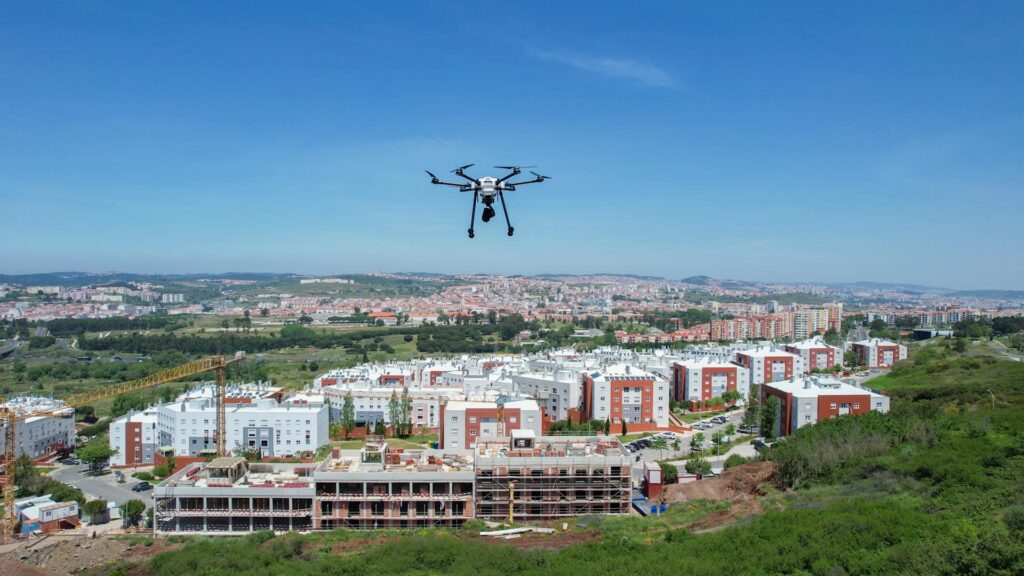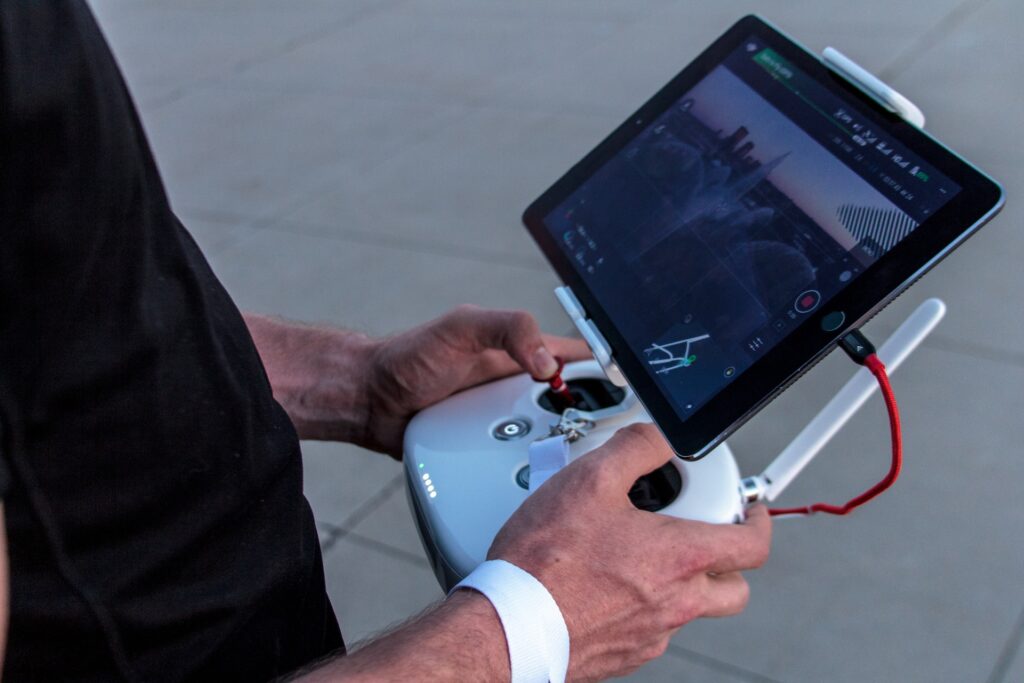Are drones the new reporters? It’s a question worth considering as unmanned aerial vehicles (UAVs) increasingly take to the skies to gather news. From covering natural disasters to tracking endangered wildlife, drones have the potential to transform how we report on the world around us. In this blog post, we’ll explore some of the ways drones are being used in journalism, provide examples of their applications, and consider the implications of their expanding role in aerial news gathering. However, before we do so, let’s briefly examine how news has traditionally been gathered up until now.

History of Aerial News Gathering
Newsgathering has come a long way since the early 20th century. In those days, the only way to capture aerial news footage was by strapping a camera to an airplane or balloon, which often proved to be a risky and unsuccessful approach. However, in the 1930s, the development of lightweight cameras and increased airplane stability led to more successful aerial photography and news organizations started to realize the potential for aerial newsgathering.
During World War II, aerial photography became crucial for military intelligence, which further advanced the technology and techniques of aerial photography. After the war, news organizations started to invest in their own aircraft and specialized photographers to capture aerial footage.
With the advent of television in the 1950s, helicopters became the preferred mode of transportation for aerial photographers as they could hover in one place and capture high-quality footage. But the advancements didn’t stop there. Today, unmanned aerial vehicles (UAVs) have revolutionized aerial news gathering. They offer a cost-effective, efficient, and safe way of obtaining images from the air, making them a valuable asset for journalists covering a range of stories, from natural disasters to wildlife conservation efforts.
Why are Newsrooms Replacing Helicopters with Drones?
Newsrooms are replacing helicopters with drones for several reasons, including cost-effectiveness, safety, and the ability to access difficult-to-reach locations.
Helicopters are expensive to operate, requiring fuel, maintenance, and a crew of pilots and technicians. In contrast, drones are much cheaper to operate and maintain, and a single operator can operate them. This cost-effectiveness allows newsrooms to gather more footage and cover more stories with limited budgets.
Safety is another critical factor. Helicopters can be dangerous and require experienced pilots and support crews. On the other hand, drones are much safer to operate and can be flown in areas where helicopters cannot go. Drones are also smaller and more agile, which allows them to get closer to the action and capture more detailed footage.
Finally, drones allow newsrooms to access difficult-to-reach locations. Drones can be flown into areas where helicopters cannot go, such as dense urban areas or remote wilderness areas. This allows newsrooms to capture footage of events and stories that would be impossible to cover with a helicopter.

Drones in Journalism
Drones in the field of journalism offer a unique and cost-effective way of capturing footage and data that was previously difficult or impossible to obtain. Drones can be particularly useful when other methods are impractical, such as in natural disasters or conflict zones. For instance, they can provide an aerial view of wildfires or hurricanes, giving journalists a unique perspective on the extent of the damage.
They are also being used to capture footage of protests and demonstrations, providing a fresh perspective that complements traditional ground-based cameras. Additionally, drones can capture footage of large crowds, giving journalists a better sense of the scale and mood of an event.
One major advantage of drones in news reporting is their mobility. They can easily navigate through difficult terrain or areas with limited access, allowing journalists to capture previously impossible footage. Furthermore, equipped with various cameras and sensors, they can provide journalists with a range of perspectives and data. For instance, thermal cameras mounted on drones can track wildlife populations or monitor the spread of wildfires.
Compared to traditional aerial photography methods, such as helicopters or airplanes, drones are much more cost-effective and can be operated by smaller teams. This means that smaller news organizations can now capture aerial footage that was previously only accessible to larger news outlets with bigger budgets.
Drone-assisted Reporting Examples
Drones have proven to be a powerful tool for creating innovative and engaging news content. Here are some examples of drone applications in news media:
In 2018, the South China Morning Post used drones to map out the entire length of the Great Wall of China, providing a stunning visual representation of one of the world’s most iconic landmarks. This feat was accomplished by combining footage captured by drones with satellite imagery to create a highly-detailed and accurate map of the Great Wall.
Similarly, the BBC in the UK used drones to create an immersive virtual reality experience that allowed viewers to explore a Roman villa. This innovative use of drones enabled the BBC to transport their audience back in time, providing a unique and interactive way to experience history.
Beyond creating immersive experiences, drones are also being used to capture footage that was previously impossible to obtain. For instance, drones equipped with high-resolution cameras can capture stunning aerial footage of landscapes, cityscapes, and events, providing viewers with a unique and captivating perspective. Drones can also be used to capture footage of wildlife, providing a way to study and monitor animal populations without disturbing their natural habitats.
In addition to the examples mentioned above, drones are also being used to capture important news footage in hard-to-reach areas. In 2016, during the Dakota Access Pipeline protests, drones were used by news organizations to capture footage of the protests from the air. This footage provided a unique and comprehensive view of the demonstrations, including the number of protesters and the extent of the police presence.
Furthermore, drones are being used to cover environmental stories, such as the impact of climate change on glaciers and coastlines. In 2019, the New York Times used drones to capture footage of melting glaciers in Greenland, providing a powerful visual representation of the effects of global warming on the planet. This footage helped to convey the urgency of the issue and the need for action to mitigate the effects of climate change.

Ethical Considerations
However, as with any new technology, the use of drones in journalism raises ethical and safety concerns. Privacy and security issues need to be addressed, and drone operators need to be aware of regulations regarding drone usage. Nevertheless, the potential benefits of drones in journalism are immense, and we can expect to see them playing an increasingly important role in news gathering in the years to come.
While the use of drones in journalism opens up exciting possibilities, it also raises important ethical questions. For example, the use of drones raises privacy concerns, as they can capture images of individuals and private property without consent. Drones can also pose a safety risk, both to those operating them and to others in the airspace. Additionally, the cost of acquiring and operating drones can be a barrier to entry for smaller news outlets, potentially creating an imbalance in coverage.
The Future of News Reporting with Drones
Object Tracking
Drones that can track and follow moving objects, such as cars or people, could help journalists to capture more dynamic footage. For example, a drone could follow a high-speed car chase or track the movements of protesters during a demonstration.
Live Streaming to Social Media
Drones that can live stream video footage directly to social media platforms could help journalists to engage audiences in real-time. For example, a drone could live stream footage of a breaking news event directly to Facebook or Twitter, allowing viewers to follow the story as it unfolds.
Automated Transcription and Translation
Drones that can automatically transcribe and translate audio from different languages could help journalists to understand and report on stories from diverse communities. For example, a drone could record an interview with a non-English-speaking source and provide a real-time translation for the journalist.
Audio and Voice Recognition
Drones that can recognize and filter out background noise or other unwanted sounds could help journalists to capture high-quality audio. This would be especially useful for interviews or other situations where clear audio is essential.
Automated Fact-checking
Drones equipped with AI algorithms could help journalists to fact-check their reporting in real-time. For example, a drone could analyze data or footage and provide a warning if there are inconsistencies or inaccuracies in the reporting.
Data Visualization
Drones that can capture data from different sensors, such as temperature or humidity sensors, could be used to create data visualizations. This would help journalists to report on complex data sets in a more engaging and accessible way.
Interactive Mapping
Drones equipped with mapping software could provide journalists with a visual representation of the area they are reporting on. This would help journalists to provide more accurate and informative reporting on events that occur in specific locations.
Social Media Monitoring
Drones that can monitor social media platforms for breaking news stories or public sentiment could help journalists to stay ahead of the curve and provide more timely reporting.

Takeaway
Journalism drone technology has the potential to revolutionize news reporting, providing new ways of gathering and presenting news. From tracking wildlife to creating immersive virtual reality experiences, the possibilities are endless. However, their expanding use in journalism also raises important ethical questions. As drones become more ubiquitous in news gathering, it’s important to consider their implications and ensure that they are used in a responsible and ethical manner.
We love to hear from you! Do you think the use of drones in journalism could lead to more objective reporting, or does it have the potential to be biased in some way? Leave us a comment in the section below.

